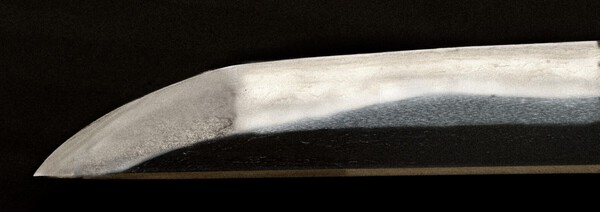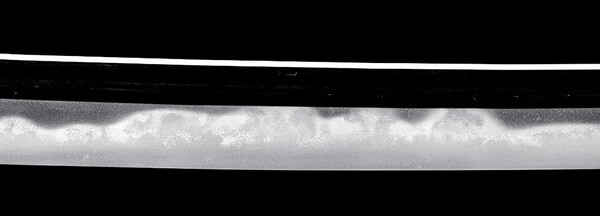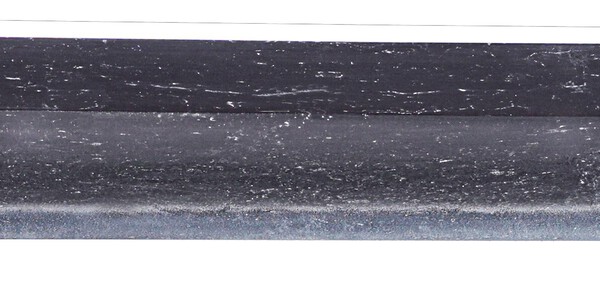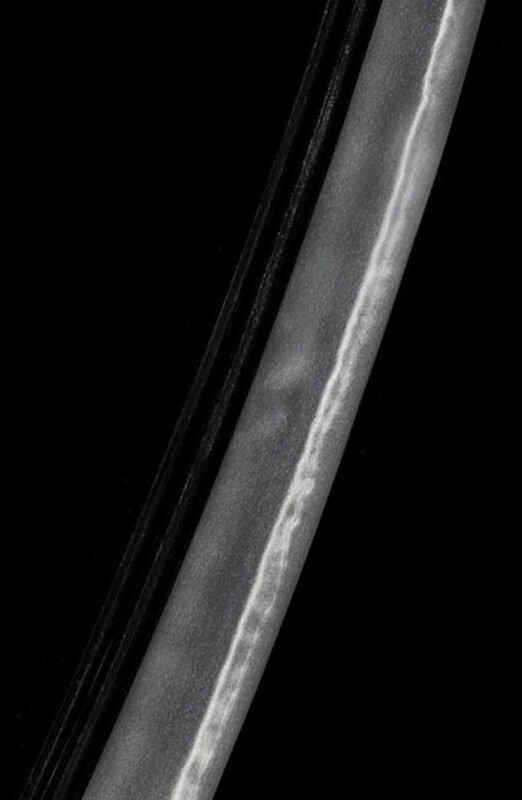-
Posts
2,336 -
Joined
-
Last visited
-
Days Won
19
Content Type
Profiles
Forums
Events
Store
Downloads
Gallery
Everything posted by Rivkin
-
Not the image I am particularly proud of, but shows the general gist. AOI's Tametsugu definitely has this Go widening and Ichimai, but very tired, jigane is gone, nie is rough... But a very rare type of "Tametsugu" with Go features, indeed.
-
It is sort of Soshu, but first and foremost what is Ichimai boshi and what is "attributed" are not perfectly defined terms. In textbook pictures you see fully and uniformly hardened kissaki with nioi-guchi located outside yokote. This is rare. And if you see Go where hamon starts to widen before kissaki and then the entire kissaki is hardened - its ichimai, and the papers typically say simply "Go". Sayagai might say "kiwame Go". Then there are pieces where it widens or not before the kissaki, but within the kissaki the hamon is simply very wide, nie+nioiguchi covers 85% of kissaki area, but there is certainly some "empty space" left out. Then the papers might as well say "Den Go". The percentage of Ichimai boshi for Go strongly depends on whether you include "Den Go". But then a dealer also can describe the wide hamon as ichimai, it happens all the time.
-

What happens to collectons?
Rivkin replied to Peter Bleed's topic in General Nihonto Related Discussion
The better the items the more effort is spend by the owner to find a single buyer-collector and make the arrangements. If the collection is not only good, but specialized, there is a high chance this happening. In which case the sale often goes with a premium compared to the market price. It is a singular chance to make such acquisition and the buyer is aware of that. If it does not happen, it goes either to dealer who might offer a lump sum (20-60% of the expected), or they sell over many years. Or it goes into auction. Christies and Sotheby have less problems securing good submission, but smaller auctions like Rock Island can sometimes offer exceptional incentives and have pre-arranged bidders, so they end up handling the sale. Sometimes the sale is completely private - they send catalogue to 3-5 people, they immediately submit bids and the matter never gets into the room. Public sales have many issues, there are always "rumors" about pieces left with nonsense descriptions on purpose, bidders who collectively agree on bids versus bidders who purposefully drive up bids on items they know will sell at some significant premium etc. etc.. For certain subjects, auctions are chaos few understand, but in every sale there is a lot going on. They get strong feedback when working on the catalogue, another feedback when they see the bids. At all times going private or splitting the collection is an option they consider. Reasonably good collection was placed on sale and they got very high bids on items they did not think much about from a person they respected. They got really scared, pulled out half the auction, sold the stuff nobody cared much about, and offered everything else privately. -

Why i dislike this dealer
Rivkin replied to lonely panet's topic in Auctions and Online Sales or Sellers
Another discussion that goes somewhere. I know a few dealers whom I reasonably trust on descriptions, photography and moneyback guarantee. I never bought much from them - they deal in things somewhat outside my interest. On the other hand Christies are awful in photography, descriptions, no warranty, false promises, random people. I bought from them and many people do. Because they have a brand and good items. Simply don't pay attention to most things they write down. There are more dangerous guys, those who do put in the effort when writing things, but either far more incompetent than they think they are (99% of dealers), or they are shrewd. Or both. Yes, Aoi Art has a thingy where they affix a koshirae to most blades they sell. I loved it as a beginner (its a real samurai sword), less than thrilled now, but there is some match between blade quality and koshirae, and even at the bottom its not "awful-awful". Big thoroughput shop with many good items. -
To an extent yes, you do see some Soshu imitations in shinto which used it, but not a typical choice. It is also seldom though a bit more often used in shinshinto, also Soshu imitations.
-
Usually it is, like Go, but it does not determines the school all by itself.
-
The blade is in polish. It might be not the best, but its a relatively recent job. Hada is opening, as on many Muromachi pieces, and is rather unsightly. Otherwise, it is Soshu, with very long muneyaki and relatively quiet hamon, which could be lesser senjo or something like Masahiro lineage. The nakago's rather sharp tapering would lean towards the former, but there is a weird outline "jump" when it starts to narrow down, might be nothing, might be it has been reworked from a more broad version... I would get papers first. It is a big question if another polish will substantially improve anything and there is one place where hamon runs very close to the edge, if not passes it. Still, it is late Muromachi Soshu, quite possibly Masahiro or Senjo school.
-
No, I was saying Muromachi additionally. It can still be 19th century, but I am more inclined to guess (there is really little), its earlier. Regarding polish - these blades need to be studied in hand, before that very light oil cover could be applied.
-
Unfortunately both out of polish, so its next to impossible to say something. They are bother either o-kissaki or extended chu kissaki, which suggests shinshinto, Momoyama or Nambokucho. The one where we can see the hamon looks a bit like Mino or Bizen from Muromachi, so might be Momoyama of this school. The one with hi - the hi is not the best cutting job I've seen, but the blade itself might be either of these three options, or less likely something else. It does not look very beefy, so also might be koto. If one is lucky even Nanbokucho, but there is zero polish so no idea.
-

Increasing Gold Membership numbers?
Rivkin replied to Brian's topic in General Nihonto Related Discussion
In the old times some forums would offer a physical "forum pin" for premier members to wear at sword shows etc.. -
Yamamura is an underappreciated smith and can be a great value. He and Nobukuni and Etchu Kuniyuki are very similar; Etchu will be darker and more hitatsura-like, Yamamura will have lighter steel and more Nobukuni hamon. There are a few generations [?] and Oei one is at the same level as Nanbokucho. But this example is at its end. Otherwise you should get something like this.
-

Increasing Gold Membership numbers?
Rivkin replied to Brian's topic in General Nihonto Related Discussion
Special finger option for platinum members! I like your unconventional thinking. -

Hitler's Samurai rare original Booklet by Heinz Corazza
Rivkin replied to Volker62's topic in Military Swords of Japan
I already mentioned it once I think, but I was involved in briefly assessing foreign ministry property which was taken as Soviet trophy. 90% was Chinese gifts from early and pre-Hitler period - vases, plaques, some artwork, contemporary or early XXth century items. There was surprisingly little Japanese. -
Seeing boshi in details would really help this one. There is potential.
-
Nihonto community is very cliquey, some groups don't like some dealers. Aoi Art is a big volume dealer and a lot of people use it, but all dealers are dangerous. On the blade - this is classic Yamamura, alternative judgement would be like Etchu Kuniyuki. Its late Nambokucho. Very tired.
-

Signed Rai Kunimitsu tachi. Price?
Rivkin replied to Lewis B's topic in Auctions and Online Sales or Sellers
I use sue Aoe as synonym of post-1380 work. The terminology does not appear in papers so its ill defined, some people do include 1350-1370s, but I find it strange because period's work while distinctive with very periodic ko choji in nioi, tight bright itame, dan utsuri, but you do find similar work in Kamakura period. It is more or less always was one of Aoe archetypes. But there is much less in common with Muromachi production and if sue Aoe covers mid Nambokucho and all later work, than all these book statements are challenging to accept since they refer to two very different styles. Muromachi Aoe style persisted in one form or another for quite sometime, one can even say until Mizuta, though the quantity drops tremendously in 1380s and even further around 1410-1420. They are not making it to Juyo so not too visible, rare and there is no published study. They are never pure nioi [!], and some are clearly nie based. They can at times approach Mizuta as Mino-Soshu interpretation, and on the other end of the spectrum you find sort of Tegai with ko choji somewhere mixed in, and besides a lot of masame you also do have tight itame, even though it does not have much ji nie. Utsuri - sometimes there is none, sometimes there is midare utsuri, sometimes its strong and somewhat unsightly bo utsuri. Dan utsuri per se is very uncommon. sumigame in its ealier form is non-existent. Its just not the same type of work as classic 1360 Juyo. Here is Muromachi Aoe from Aoi Art. It is unusual, but on the other hand - that's what they started to experiment with. P.S. the one from eirakudo could not be Aoe from 1350-1370. utsuri is wrong - period Aoe has a fold in a very specific place which produces nie, location is below the one in eirakudo. at TH level the location is prone to. eirakudo ashi are too non-uniform in height, there is notare periodicity to their heights rather than pure suguha, etc. etc. etc. -

Signed Rai Kunimitsu tachi. Price?
Rivkin replied to Lewis B's topic in Auctions and Online Sales or Sellers
I don't think sue Aoe was considered; Regarding the rest I think we are running into competitive nomenclature: when sue Aoe begins, and I am sort at fault for saying "sue Aoe" when I should have used "Muromachi Aoe". Yes, it has rougher jigane compared to Nanbokucho, and can or even expected to have noticably harsher nie activity. (see attached). Some look like Mihara or even Tegai with nijuba, others go all the the way to Yamato Shikkake-Mino with togari etc. Though they are rare, they are also often signed pieces, so no question on attribution. Even with blades from the very end of Nanbokucho (1380s) you have people who continue the tradition, and there are blades reflecting an effort to copy different styles with at times random effect, you see bizarre pieces, but still high quality. Regarding distinctive saka ashi... I can put 10 or 20 images from different blades and while there is this "Aoe" look, whether its saka or not it is not always clear. In real life, depends on polish, lighting, can be even worse. At TJ level there are many pieces which are "classic" Aoe with everything in the book present... When its TH, it all gets murky and Aoe is one school which can be difficult to kantei - jigane varies a LOT, hamon also, and Muromachi pieces you are essentially looking for one or two not too obvious features which confirm its Aoe. Aoe is unfortunately a school which can't be studied by books or even NBTHK newsletter. There is too much variation, and its often difficult to see what you need to see. You speak to people appraising sue Aoe and they say - here is nezumi ashi, saka ashi, but when you look at it - its very subtle, in one place, you show it to another person and he will not see it and will give different appraisal. -

Yasuhiro information (more pics coming)
Rivkin replied to William Jennings's topic in General Nihonto Related Discussion
Glad to see the culprit seems to be my tolerance towards opinions based on what I believe to be the most likely, rather than proven or even very likely scenario. That's something I am comfortable with. -

Signed Rai Kunimitsu tachi. Price?
Rivkin replied to Lewis B's topic in Auctions and Online Sales or Sellers
I wanted to answer with more pictures, so I got lazy. Yes, these are more or less identical portions. Sugata is not distinctive to period. Middle one is very much how the blade looks under most lights - and NTHK attributed it to late Muromachi Kaga, which is understandable. Enju attribution was late Kamakura, and Aoe guess would be also late Kamakura. I feel sue-Aoe and sue-Enju both look frankly Yamato or Yamato-Mino, with coarser jigane, strong nie activity, togari-gunomi, sunagashi etc. What botheres me in Enju is that the last photo on the rightmost side has couple of strings of ko nie and that's about all I could find which would point me towards Mihara or Enju. I don't think there is nijuba, to me it looked more like ko choji hamon in nioi which gets weaker in one area, which is almost impossible to see with a naked eye. Very complex blade, very complex photography. -

Yasuhiro information (more pics coming)
Rivkin replied to William Jennings's topic in General Nihonto Related Discussion
It can be post-suriage. Unusual placing, unusual choice of yasurime type, not exactly clear why above it seems to become more typical for post-suriage yoko yasuri (or is it?), but theoretically it can be. I don't take this as the most likely scenario. But it would be interesting however if other people (not you, Jacques) would start voicing opinions instead of myself being the sole kantei expert around here. I would gladly learn something. -
Funny thing, I have not seen kogarasumaru style blade (except the original, and its dating is also an interesting story) which predated shinshinto, and most are Showa. This is Showa with dense jigane and very bland hamon, with nakago that someone worked for days to age.
-

Signed Rai Kunimitsu tachi. Price?
Rivkin replied to Lewis B's topic in Auctions and Online Sales or Sellers
Left to right - her picture, how it looks in real life, how it looks after two days of dancing around with light sources and trying to understand why I can't capture the leftmost image. And hand pushing contrast to maximum. NTHK [NPO?] circa 2023: Kaga late Muromachi, no noticable activity, suguha, itame. NBTHK: utsuri, ashi, attributed to Enju Myself: why Enju, hamon is pure nioi with a little bit of ko nie, if you believe leftmost image (I believe its there, just does not show very well), or even my rightmost one (two days of pain), it even borders on ko choji in places. Aoe. Kantei guy after 10 minutes: Obviously its Aoe. Yes, ashi, complex utsuri. Did NBTHK consider ko nie activity like the one seen in third photo as an indication its Enju? I don't know. I had an opportunity to ask couple of questions through an intermediary but that's it. -
Unfortunately can't see jigane. Evening, light from a side can fix that. I like what I see though, probably Soshu imitation. Regarding the signature I would deal with it after studying the work itself.
-
I have to apologize for being straightforward, but I will mention right away that I also would appreciate having a sword with horimono like this and looking at it from time to time. But this is a very recent style, 20th century, possibly early Showa. The elements are flat rather than 3D to the point that most elements are just accented as contours, you don't see actually scales of the dragon etc.. Ambitious but the execution is fast.
-

Yasuhiro information (more pics coming)
Rivkin replied to William Jennings's topic in General Nihonto Related Discussion
Away from all my books, thus shooting from a hip: well known Yasuhiro from Ishido school did not use takanoha. Also one of the ana hints koto. Unlisted smith Yasuhiro, end of Muromachi, Mino.












